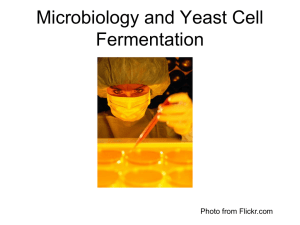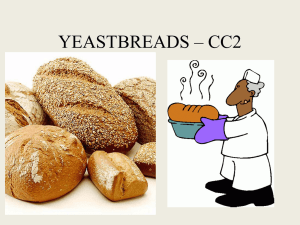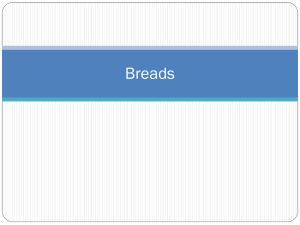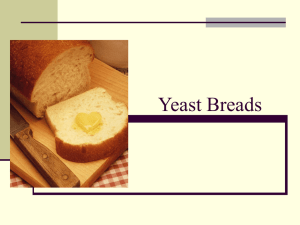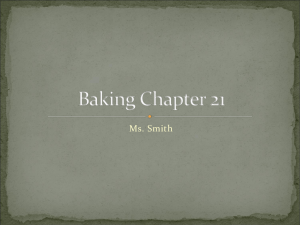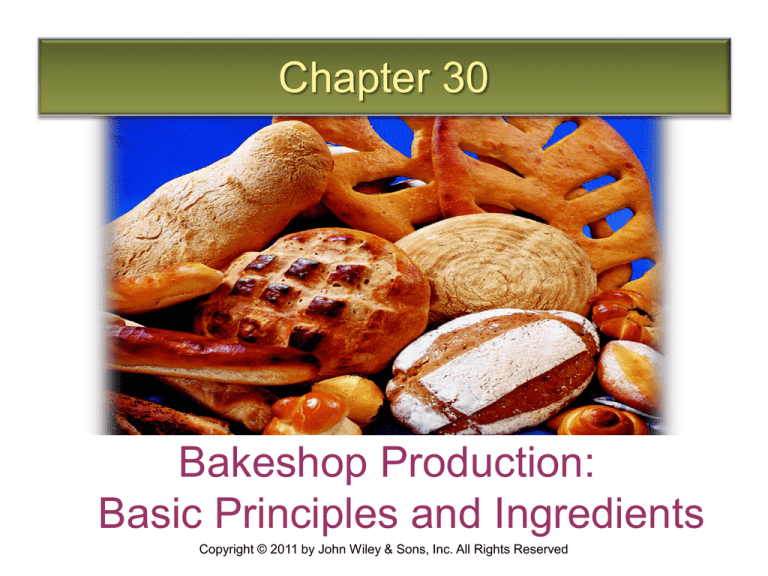
Chapter 30
Bakeshop Production:
Basic Principles and Ingredients
Copyright © 2011 by John Wiley & Sons, Inc. All Rights Reserved
Understanding Yeast Products
Yeast Product Types
Regular Yeast Dough Products
• Lean dough
• Low in fat and sugar.
• Rich Dough
• Generally contains higher proportions of fat, sugar, and
sometimes eggs.
2
Understanding Yeast Products
Yeast Product Types
Rolled-In Yeast Dough Products
• Rolled-in or laminated doughs
• Fat is incorporated into the dough in many layers by means of a
rolling and folding procedure.
• The alternating layers of fat and dough give the baked
product a flaky texture.
• Non-sweet rolled-in doughs, such as croissants.
• Sweet rolled-in doughs, such as Danish pastries.
3
Understanding Yeast Products
Mixing Methods
Mixing yeast doughs has three
main purposes:
1. To combine all ingredients into a
uniform, smooth dough.
2. To distribute the yeast evenly
throughout the dough.
3. To develop gluten.
4
Understanding Yeast Products
Mixing Methods
Three principal mixing methods are used for
yeast doughs:
1. The straight dough method.
2. The modified straight dough method.
3. The sponge method.
5
Understanding Yeast Products
Steps in Yeast Dough Production
The production of yeast breads involves 12 basic
steps:
1. Scaling ingredients
7. Benching
2. Mixing
8. Makeup and panning
3. Bulk fermentation
9. Proofing
4. Folding or punching
10. Baking
5. Scaling or portioning of
dough
11. Cooling
6. Rounding
12. Storing
6
Understanding Yeast Products
Steps in Yeast
MixingDough
Methods
Production
Scaling Ingredients
• All ingredients must be weighed accurately.
• The only items that may be measured by volume are
water, milk, and eggs, which may be scaled at 1 pint
per pound (1 L per kg).
7
Understanding Yeast Products
Steps in Yeast Dough Production
Mixing
• The first two purposes of mixing—combining the
ingredients into a dough and distributing the yeast—are
accomplished during the first part of mixing.
• Use the dough arm attachment when using a vertical mixer. Mix
for the specified time.
• The remaining time is necessary to develop the gluten.
• Over-mixed and under-mixed doughs have poor volume and
texture.
8
Understanding Yeast Products
Steps in Yeast Dough Production
Bulk Fermentation
• Fermentation is the process by which yeast acts on the
sugars and starches in the dough to produce carbon
dioxide gas and alcohol.
• Gluten becomes smoother and more elastic during
fermentation.
• An under-fermented dough is called a young dough.
• An over-fermented dough is called an old dough.
9
Understanding Yeast Products
Steps in Yeast Dough Production
Scaling or Portioning of Dough
• Using a baker’s scale, divide the dough into pieces of
uniform weight, according to the product being made.
• Allowance is made for weight loss due to evaporation of
moisture in the oven.
• Allow an extra 1½ to 2 ounces of dough per 1 pound of
baked bread (or an extra 50 to 65 grams per 500 grams
baked bread).
10
Understanding Yeast Products
Steps in Yeast Dough Production
Rounding
• The pieces of dough are shaped into
smooth, round balls.
• Rounding forms a kind of skin by
stretching the gluten on the outside
of the dough into a smooth layer.
• Rounding simplifies later shaping of
the dough and also helps retain
gases produced by the yeast.
11
Understanding Yeast Products
Steps in Yeast Dough Production
Benching
• Rounded portions of dough are allowed to rest on the
bench for 10 to 15 minutes.
• This relaxes the gluten to make shaping the dough easier.
• Fermentation continues during this time.
12
Understanding Yeast Products
Steps in Yeast Dough Production
Make-up and Panning
• Dough is shaped into loaves or rolls and placed in pans
or on baking sheets.
• For all loaves and rolls, the seam must be centered on the
bottom to avoid splitting during baking.
13
Understanding Yeast Products
Steps in Yeast Dough Production
Proofing
• A continuation of the process of yeast fermentation
• This process increases the volume of the shaped
dough.
• Under-proofing results in poor volume and dense texture.
• Over-proofing results in coarse texture and some loss of flavor.
• Rich doughs are slightly under-proofed because of their weaker
gluten structure.
14
Understanding Yeast Products
Steps in Yeast Dough Production
Baking
• Important changes take place in a dough during baking:
1. Oven spring
•
The rapid rising in the oven due to production and expansion of
trapped gases as a result of the oven heat.
2. Coagulation of proteins and gelatinization of starches.
3. Formation and browning of the crust.
15
Understanding Yeast Products
Steps in Yeast Dough Production
Baking
• Oven temperatures must be adjusted for the product
being baked:
• Lean breads are baked at 400° to 425°F (200° to 220°C).
• Rich doughs and sweet doughs are baked at a lower
temperature, 350° to 400°F (175° to 200°C).
• Hard-crusted breads are baked with steam injected into the
oven during the first part of the baking period.
• This aids the formation of a thin, crisp crust.
16
Understanding Yeast Products
Steps in Yeast Dough Production
Cooling
• Bread must be removed from pans and cooled rapidly
on racks.
• This allows the escape of excess moisture and alcohol created
during fermentation.
• Do not cool in a draft, or crusts may crack.
17
Understanding Yeast Products
Steps in Yeast Dough Production
Storing
• Breads to be served within 8 hours may be left on
racks.
• For longer storage, wrap cooled breads in moisture
proof bags to retard staling.
• Wrapping and freezing maintains quality for longer
periods.
• Refrigeration increases staling.
• Hard-crusted breads should not be wrapped (unless frozen), or
the crusts will soften.
18

